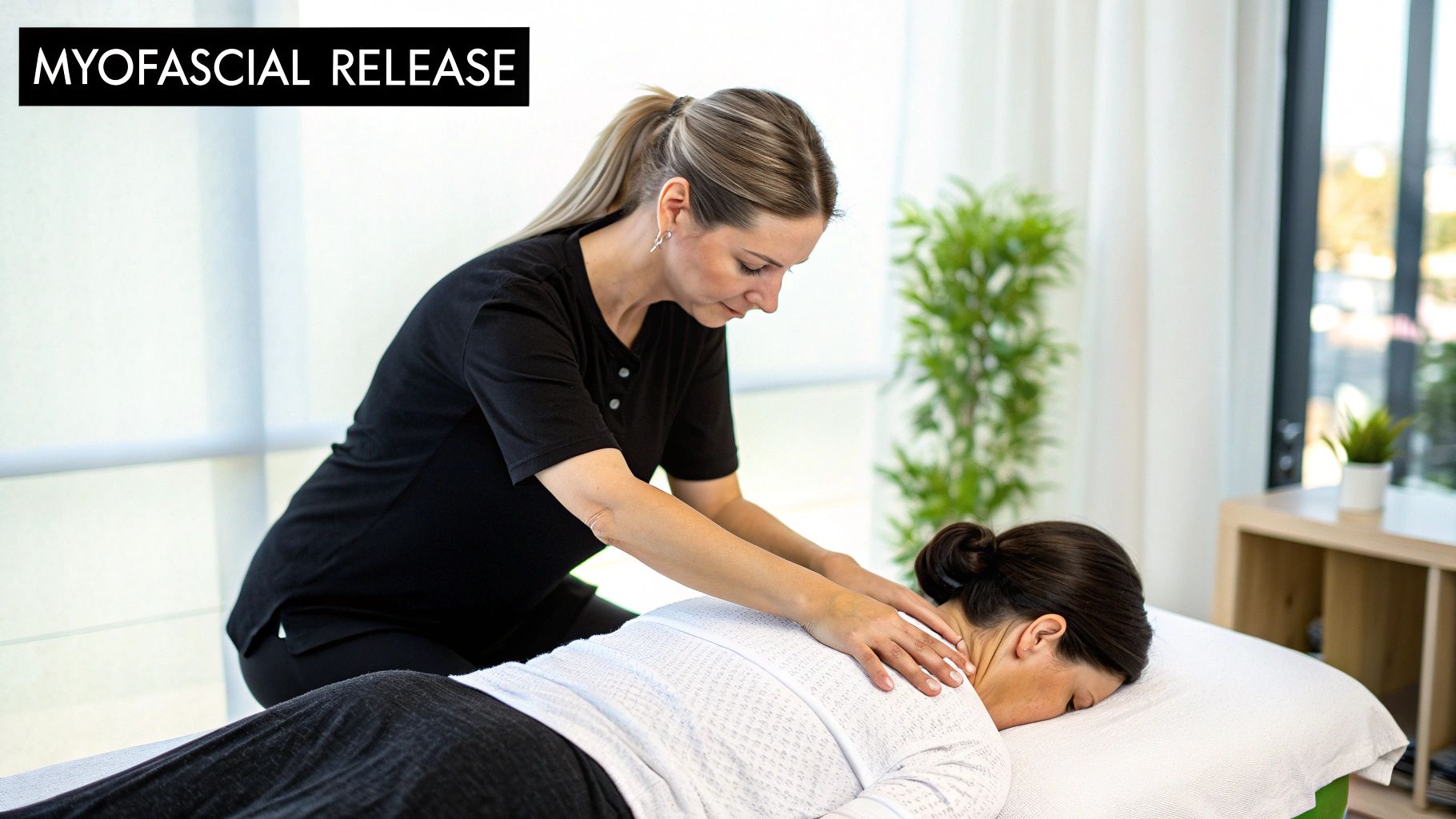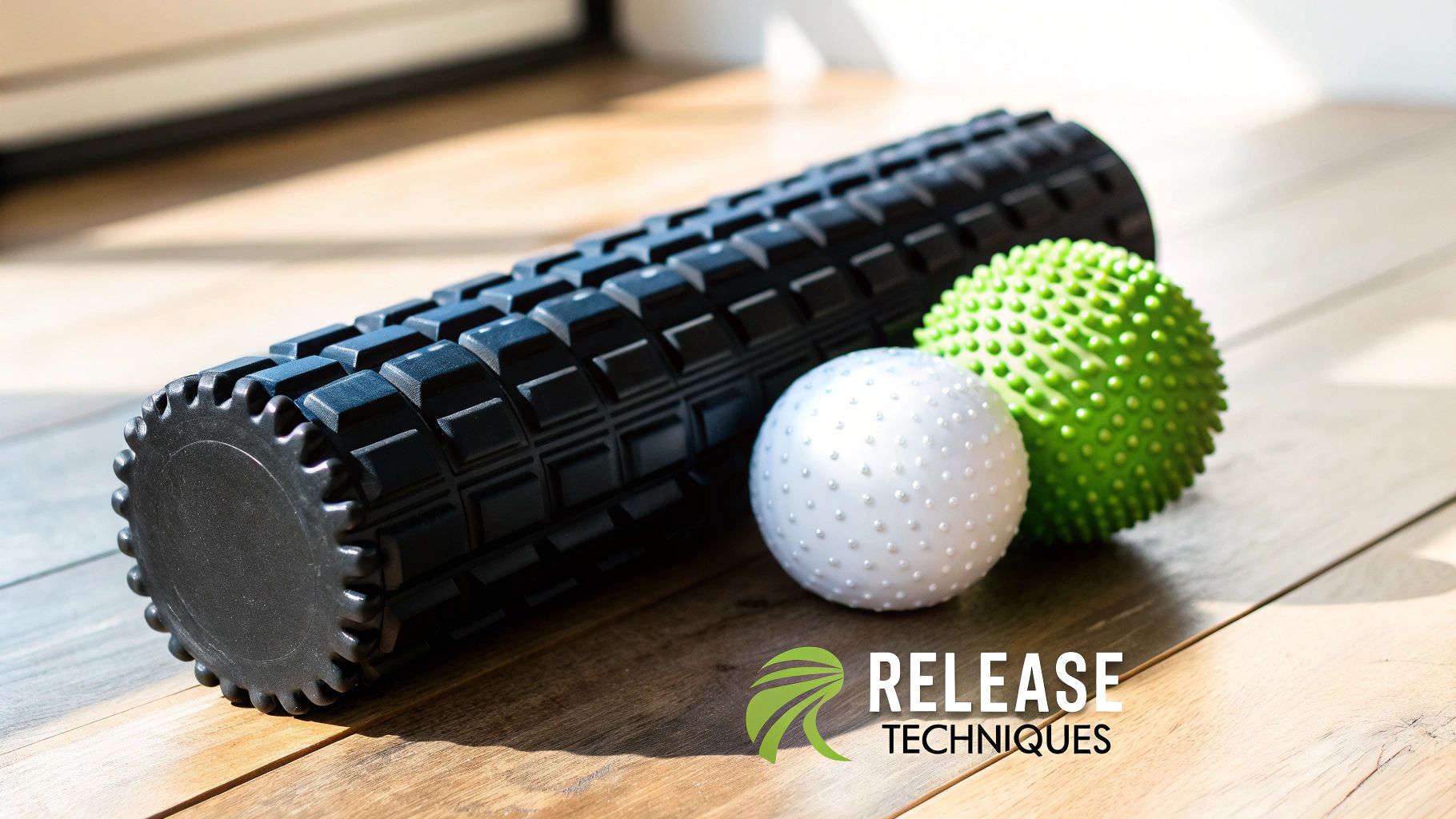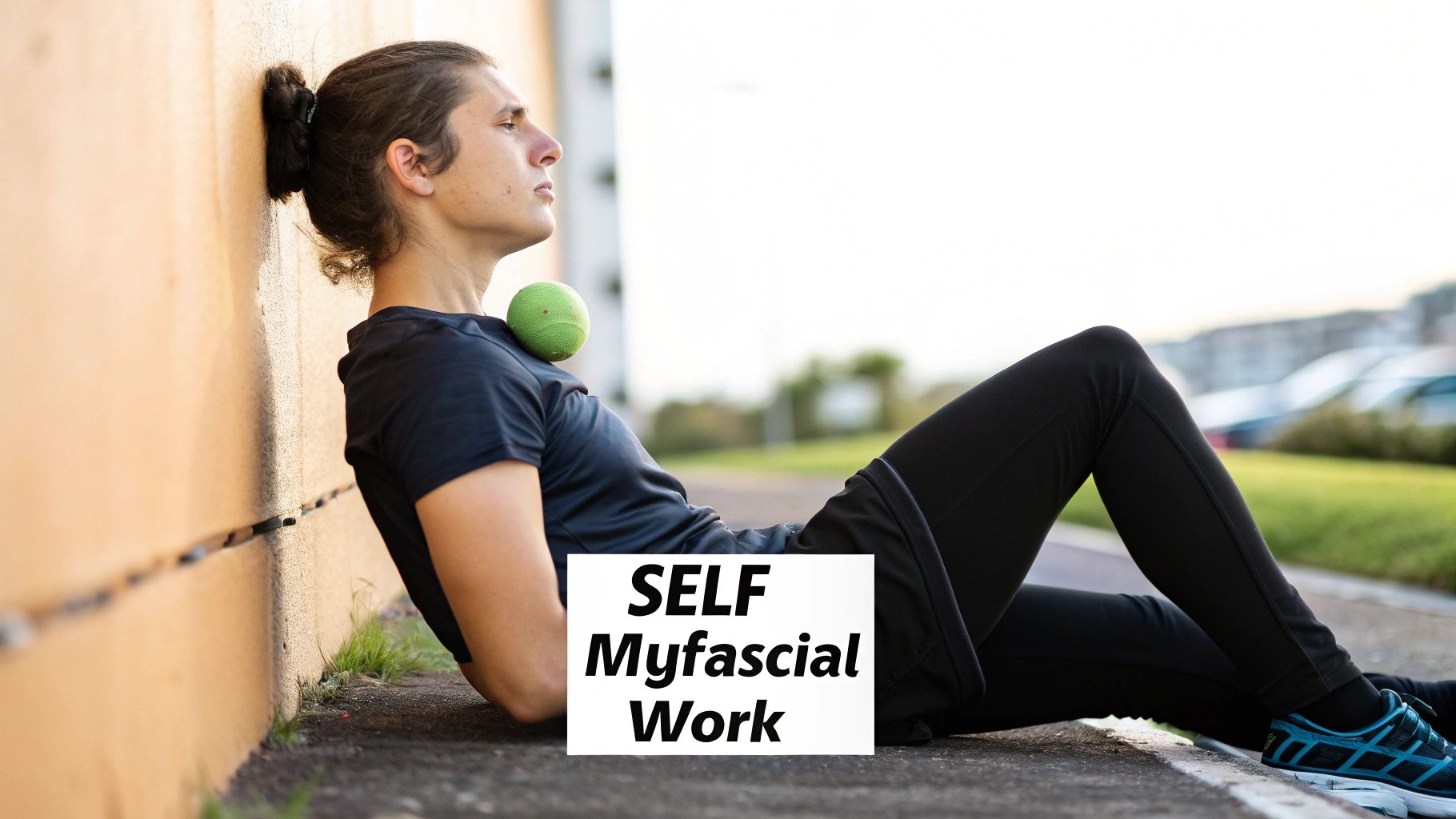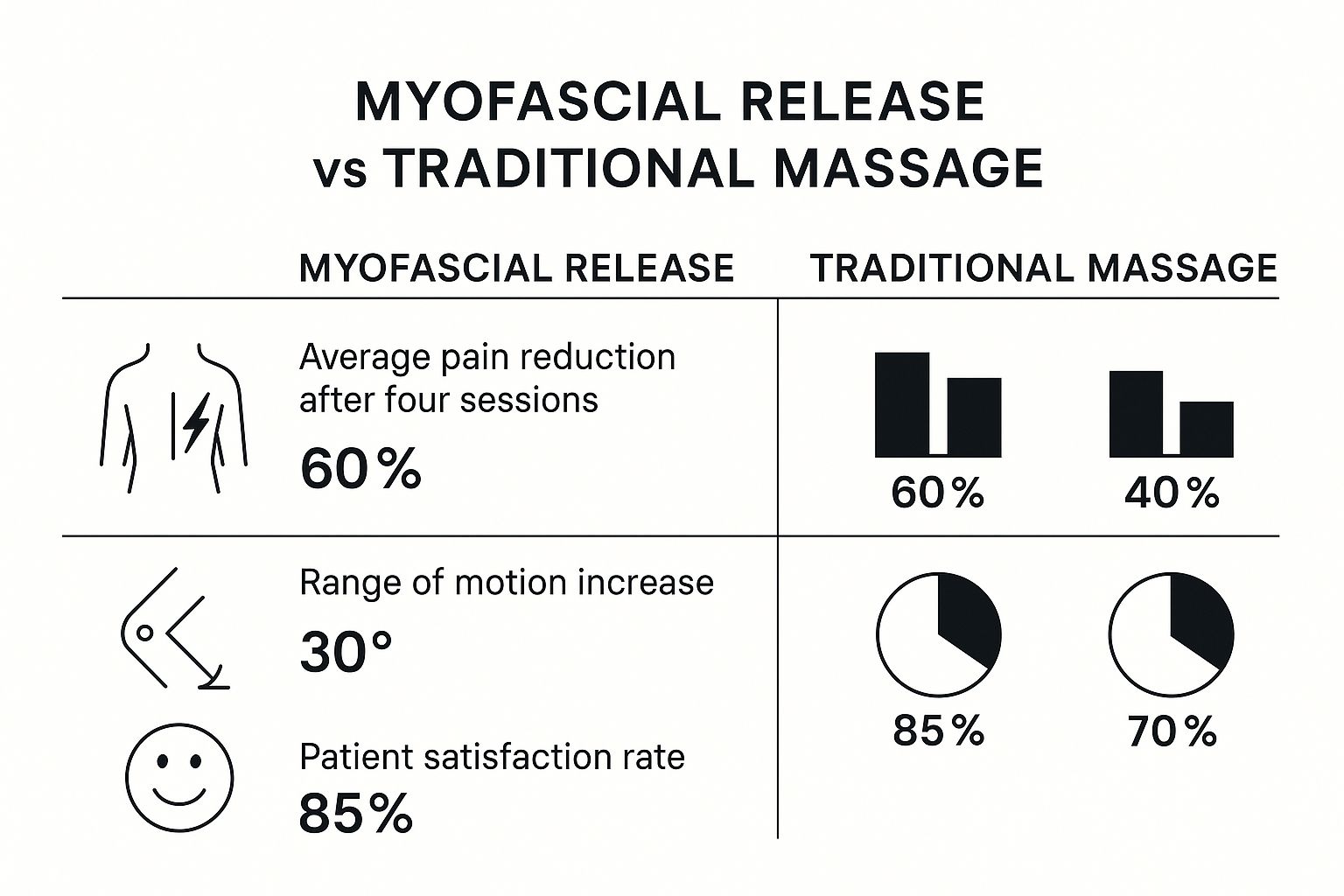Myofascial Release Therapy for Pain Relief

Myofascial release therapy is a highly effective, hands-on treatment that gets to the root of stubborn pain and stiffness. It’s all about targeting the body's fascia—a complex, web-like system of connective tissue. Using slow, sustained pressure, a therapist can release tightness and "knots" in this tissue, restoring your natural freedom of movement.
Think of it this way: your fascia is like a thin, yet incredibly strong, layer of shrink-wrap covering every single muscle, bone, and organ. When it's healthy, it's smooth and flexible. But when it gets tight or stuck, it can pull on everything it surrounds, causing pain and limiting how you move.
Unlocking a Deeper Layer of Pain Relief

When you're dealing with persistent aches and that feeling of being constantly "tight," it’s easy to blame your muscles. And while they're part of the equation, the real problem often lies a layer deeper in your fascia.
Let's use another analogy. Imagine you're wearing a perfectly fitting, full-body sweater. It moves with you, no problem. Now, what if you get a snag in the shoulder? That one little snag doesn't just stay put—it pulls and creates tension across your chest, down your arm, and up your neck. That’s precisely how restricted fascia behaves. It creates problems far from the original site of the "snag."
This is where myofascial release therapy shines. Unlike a typical massage that might use faster strokes to work the muscles, this technique involves a therapist applying very slow, sustained pressure directly into a fascial restriction. This gentle but firm force gives the stiff, dehydrated fascia enough time to soften, lengthen, and get back its healthy, pliable texture. The goal isn't just to knead the muscle below, but to completely free up the tissue that’s holding it hostage.
Core Concepts of This Therapy
To really get a feel for how myofascial release works, it's helpful to see its core principles laid out. These are the foundational ideas that set it apart from other types of bodywork.
For a quick overview, this table breaks down the essentials of the therapy.
| Concept | Description | Primary Goal |
|---|---|---|
| Fascial Web Focus | The therapy treats the entire body as a single, interconnected system of connective tissue, not as isolated parts. | To address the root cause of pain, which may originate far from where it's felt. |
| Sustained Pressure | Gentle pressure is held on a restricted area for 3-5 minutes or longer, without oils or lotions. | To allow the tough, fibrous fascia enough time to slowly melt, lengthen, and release. |
| Restoring Mobility | The technique focuses on re-establishing the natural glide between fascial layers and the structures they surround. | To eliminate pain, improve range of motion, and restore overall functional movement. |
These principles work together to create profound and lasting change in the body's tissues.
"The fascial system is a three-dimensional web of connective tissue that surrounds, supports, and penetrates all muscles, bones, nerves, and organs. When it becomes restricted, it can create pain and dysfunction throughout the entire body."
A Different Approach to Healing
Myofascial release has deep roots in osteopathic medicine. Its origins can be traced back to Andrew Taylor Still, the founder of osteopathy, in the late 1800s. He was one of the first to truly recognize how restrictions in this tissue web could jam up the body's innate ability to heal itself—a core principle that still guides therapists today.
While myofascial release therapy zeroes in on the fascial system, it's one of many powerful tools for pain relief. For anyone curious about other hands-on treatments, you might find it useful to check out our guide on what is therapeutic massage and how it differs. But when it comes to untangling fascial restrictions, this specific approach truly stands on its own as a way to unlock lasting relief.
Getting to Know Your Body's Fascial Network
To really get what myofascial release therapy does, you first have to understand what it works on: your fascia. This isn't just some passive "packing material" filling the empty spaces in your body. It's an active, intelligent system that plays a huge role in how you move, how you feel, and how your body functions as a whole.
The best way to picture it is as a single, seamless web of connective tissue, almost like a 3D spiderweb, woven throughout your entire body. This amazing network wraps around every single muscle, bone, nerve, and organ, connecting you from head to toe. This is your fascia, and it's what gives your body its form and structure.
What Is Fascia Made Of?
Fascia gets its unique qualities from what it's made of. At its core, it's a mix of tough protein fibers floating in a gel-like liquid known as the ground substance.
- Collagen Fibers: Think of these as tiny, incredibly strong cables. They provide immense tensile strength and support, preventing your tissues from being overstretched or torn. They give fascia its toughness.
- Elastin Fibers: Just like the name implies, these fibers are stretchy. They allow the fascia to be pliable, giving you the flexibility to move freely and without feeling restricted.
When everything is working right, this combination of strong collagen and stretchy elastin, all lubricated by the ground substance, allows for a smooth, effortless glide between tissues. Your muscles can contract, your limbs can move, and everything just works. It's a beautifully designed system for seamless motion.
Your fascial system isn’t just a bunch of separate coverings. It's one continuous, interconnected network. When you pull or tighten one part of this web, that tension can ripple out to distant areas—much like tugging on a thread in a sweater can cause a pucker somewhere else entirely.
When Good Fascia Goes Bad
Unfortunately, this finely tuned system can get thrown out of whack. Things like a sudden injury, the repetitive strain from your favorite sport, chronic stress, or even just sitting with bad posture can cause your fascia to change for the worse. The tissue, which should be supple and hydrated, starts to dry out and stiffen up.
It's like the difference between a wet sponge and a dry one. The wet sponge is soft and pliable, but when it dries out, it becomes hard and brittle. When fascia dehydrates, the collagen fibers can begin to stick to each other, forming dense, tough spots we call adhesions or "knots."
These adhesions are a big deal. They aren't just sore spots; they can put a tremendous amount of tension on whatever they're surrounding—sometimes creating pressure of up to 2,000 pounds per square inch. That kind of constant force can compress nerves, choke off blood flow, and seriously limit how well your muscles can work.
The Domino Effect of Tight Fascia
Once an adhesion forms, it creates a drag on the entire fascial web. This is the key reason why the source of your pain is often not where you actually feel the ache.
For instance, a fascial restriction in your neck—maybe from hunching over a laptop all day—can create a pulling tension down your back and into your shoulder. You might feel a nagging pain in your shoulder, but rubbing it will never provide lasting relief. Why? Because the root cause, the "snag" in the fascial web, is actually in your neck. This phenomenon, where pain shows up in a seemingly unrelated spot, is a classic sign of fascial trouble.
Understanding this interconnectedness is crucial. It’s why myofascial release therapy is so effective. Instead of just chasing the symptom (the sore shoulder), the therapy aims to find and release the source of the problem (the neck adhesion), bringing the whole system back into balance.
How Trigger Points Create Referred Pain

We’ve all felt them—those stubborn, painful “knots” that seem buried deep inside a muscle. They’re more than just simple sore spots. In myofascial release therapy, we call these Myofascial Trigger Points (MTrPs), and they're the tiny, hyper-irritable epicenters of dysfunction within your fascia.
A trigger point is a small, contracted nodule inside a taut band of muscle tissue. What makes it so tricky is its ability to "broadcast" pain to other, seemingly unrelated parts of the body. This is a phenomenon called referred pain, and it’s why so many aches and pains feel mysterious and are so hard to pin down.
For instance, you might be dealing with persistent headaches that feel like they're coming from behind your eye. You could try everything to treat the headache directly, but the real culprit might be a trigger point in your upper trapezius muscle, which is referring that pain signal all the way up into your head.
The Science Behind Referred Pain
So, how does a knot in your shoulder cause a headache? It all comes down to the nervous system. When a trigger point forms, it creates constant, low-level irritation. This sends a barrage of pain signals to your spinal cord, which can get overwhelmed and confuse your brain about where the pain is actually originating.
This concept isn't new. It was explored in depth during the 20th century by pioneers like Drs. Janet Travell and David Simons. Starting in the 1940s, they painstakingly mapped out these trigger points and their corresponding referred pain patterns. Their work culminated in the foundational 1983 text, 'Myofascial Pain and Dysfunction: The Trigger Point Manual.' And there's compelling evidence of how powerful this connection is; a 1980 study found that 80% of patients reported pain relief after receiving simple saline injections into their trigger points. You can learn more about the history of trigger point research and its findings.
Real-World Examples of Referred Pain
Understanding these pain maps is the key to finally getting relief. Here are a few classic examples I see all the time:
- Sciatica-Like Symptoms: A trigger point in the gluteus minimus muscle can shoot sharp, radiating pain down the back of the leg, perfectly mimicking the symptoms of true sciatica.
- Tension Headaches: As we mentioned, trigger points in the neck and upper shoulders are notorious for causing headaches that feel like a tight band around the head or a dull ache behind the eyes.
- Jaw and Tooth Pain: Knots in the masseter (jaw) muscle can refer pain directly into the teeth, making people think they have a dental problem when the issue is purely muscular.
Myofascial release therapy is designed specifically to hunt down these pain generators. It’s not like a general massage that temporarily soothes a sore area. Instead, it uses slow, sustained pressure directly on the trigger point.
This targeted pressure helps to "deactivate" the trigger point. The idea is to release the contraction, bring blood flow back to the starved tissue, and break that cycle of persistent pain signals. By treating the source, both the local tenderness and the referred pain can finally start to resolve. This is also a key principle in self-care, and you can learn more about how to get rid of muscle knots on your own in our guide.
The Tangible Benefits of Myofascial Release

It’s one thing to understand the science behind myofascial release, but what really matters is how it feels in your own body. This isn't just theory; it’s a therapy that delivers real, tangible improvements, helping you move from a state of constant discomfort to one of genuine ease. We're not just talking about temporary relief, but about restoring your body's natural balance.
For so many people, the biggest win is a dramatic reduction in chronic pain. Conditions that just won't quit—like fibromyalgia, tension headaches, and nagging low back pain—often have a strong fascial component. By releasing the deep-seated restrictions that pinch nerves and pull on muscles, this therapy can turn down the volume on those persistent pain signals that get in the way of your life.
This is particularly true for anyone dealing with the postural strain of modern life. All those hours spent slumped over a desk can cause the fascia in your neck, shoulders, and hips to shorten and tighten, pulling you into that familiar forward hunch. Myofascial release works to lengthen these exact tissues, helping you stand taller and sit more comfortably without even thinking about it.
Unlocking Greater Freedom of Movement
One of the first things people notice is a profound improvement in their range of motion. When your fascia is tight and restricted, it’s like trying to move while wearing a jacket that’s two sizes too small. Every movement feels stiff and requires far too much effort. Freeing up these adhesions lets your muscles and joints glide past each other the way they were designed to.
By restoring the natural slide and glide between fascial layers, myofascial release therapy helps you move with more ease and less tension. This translates to deeper squats, a fuller golf swing, or simply being able to reach the top shelf without wincing.
This can be a complete game-changer, especially if your job or lifestyle involves repetitive motions or long periods of sitting. If you're struggling with discomfort from being at a desk all day, you can find other effective strategies to reduce back pain from prolonged sitting that work well alongside this therapy to build a more resilient body.
Boosting Athletic Performance and Recovery
For athletes and active people, healthy fascia isn't just a nice-to-have; it's essential. It’s the key to powerful, efficient movement and staying off the sidelines. Myofascial release can give you a real edge by targeting a few critical areas:
- Accelerated Muscle Recovery: The therapy boosts circulation to tired tissues, helping to flush out the metabolic byproducts that cause soreness. This means you can bounce back faster between tough workouts.
- Enhanced Performance: When your muscles aren't being held back by tight fascia, they can contract more powerfully and efficiently. This can lead to real, measurable improvements in strength, speed, and overall athletic output.
- Injury Prevention: By releasing imbalances and adhesions, you correct faulty movement patterns before they can turn into strains, tears, or other serious injuries.
Whether you're an office worker looking for relief from a stiff neck or a runner chasing a new personal best, myofascial release offers a clear path to a more functional life. While it's a unique practice, it shares a common goal with other wellness techniques. If you're exploring ways to manage discomfort, our guide to pain relief massage therapy can offer more insight into other effective hands-on approaches.
Choosing Your Myofascial Release Method
So, you’re ready to tackle those tight spots and fascial restrictions. Great. You’ve got two main routes you can go down: working with a trained professional or taking matters into your own hands with some at-home tools.
Both paths are incredibly valuable. One gives you expert guidance and precision, while the other offers everyday convenience and control. Honestly, the best approach isn’t always an either/or choice. For many people, a smart combination of both delivers the most profound and lasting relief. Let's break down what each option looks like.
Working with a Myofascial Release Professional
Going to a certified professional—like a physical therapist or a licensed massage therapist who specializes in this work—is the gold standard for dealing with complex or stubborn issues. Think of it as calling in an expert mechanic for your body.
During a session, a therapist uses their hands, knuckles, or even elbows to apply slow, sustained pressure to those sticky, restricted areas. Their fingers are trained to feel for the subtle changes in tissue texture, hunting down adhesions you probably don't even know exist. This skilled touch is what makes all the difference.
A pro has a whole toolbox of techniques they can tailor specifically to you:
- Direct Myofascial Release: This is the classic approach. The therapist sinks deep into a restriction with steady pressure and holds it, waiting for the tissue to finally let go. It's incredibly effective for breaking up those really stubborn knots and trigger points.
- Indirect Myofascial Release: A much gentler method where the therapist applies a light stretch, allowing your body's own reflexes to unwind the tension naturally. It coaxes the fascia to release rather than forcing it.
Best of all, a therapist can connect the dots. They can figure out why your shoulder pain is actually coming from your tight pecs, addressing the root cause instead of just chasing the symptoms around.
Self-Myofascial Release at Home
Self-myofascial release, or SMR, is all about empowering you to take care of your own tissues. This is your daily maintenance plan, perfect for managing general soreness, boosting flexibility, and keeping the benefits of your professional sessions going strong.
It’s your at-home kit for keeping your fascia happy and healthy. The most popular tools of the trade are probably already familiar:
- Foam Rollers: Your go-to for big muscle groups like the quads, hamstrings, and back.
- Therapy Balls: Perfect for zeroing in on smaller, trickier spots like the arches of your feet, your hips, or between your shoulder blades.
- Massage Guns: These use percussion (rapid pulsing) to break up tension and flood the area with blood flow.
The real magic of SMR is consistency. A professional can hit the reset button, but it’s the daily self-care that prevents new restrictions from setting up shop and keeps you feeling mobile and fluid.
A Head-to-Head Comparison
To help you figure out where to start, it's useful to see how professional therapy and SMR stack up against each other. They each have their strengths, and understanding them will help you build the right strategy for your body and your goals.
Comparing Professional Therapy vs. Self-Myofascial Release
| Aspect | Professional Therapy | Self-Myofascial Release (SMR) |
|---|---|---|
| Precision | Extremely high. A trained therapist can identify and treat specific fascial restrictions with expert accuracy. | Variable. Your ability to target the right spot depends on your own anatomical knowledge and body awareness. |
| Cost | Higher per session. You are paying for the therapist's time, expertise, and diagnostic skill. | Lower initial investment. Once you purchase a tool like a foam roller, it can be used indefinitely. |
| Convenience | Requires an appointment. You need to schedule sessions and travel to a clinic or spa. | Highly convenient. Can be done anytime, anywhere, making it perfect for daily maintenance or pre-workout warm-ups. |
| Best For | Complex or chronic pain, diagnosing referred pain, and creating a foundational treatment plan. | General soreness, daily maintenance, improving flexibility, and post-workout recovery. |
Ultimately, there’s no wrong choice here—both paths lead to a healthier fascial system. A professional can give you a clean slate and teach you where to focus your efforts, while SMR gives you the power to maintain those amazing results every single day.
When to Seek Professional Guidance
While self-myofascial release is fantastic for day-to-day upkeep, some situations just call for the skilled hands and diagnostic eye of a trained professional. Think of it this way: your foam roller is like a daily tune-up for your car, but professional myofascial release therapy is the deep-dive work done by a master mechanic who can find and fix the root of a tricky problem.
Knowing when to graduate from your living room floor to a therapist's table is crucial for your safety and for getting the results you're after. A certified pro can trace complex pain patterns and apply targeted treatments you simply can't replicate by yourself.
Finding a Qualified Practitioner
When you decide it's time for professional help, finding someone with the right credentials is a must. Not all massage therapists are trained in the specific, slow, sustained-pressure techniques that make this therapy so effective. You'll want to look for practitioners who have specialized training and certifications under their belt.
Your best bet is often one of the following:
- A Licensed Physical Therapist who has direct experience and coursework in myofascial release.
- A Certified Massage Therapist with advanced, dedicated training in myofascial techniques.
- An Osteopathic Physician who uses manual therapies as a core part of their practice.
Don't be shy about asking about their training and experience, especially with issues like yours. A good practitioner will have a solid grasp of the fascial system and know how to work with its restrictions safely and effectively.
A huge part of a professional session is the practitioner's ability to "listen" to your tissue. They can actually feel how your fascia is responding to pressure, changing their approach in real-time to get the best possible release. That’s a level of feedback you just can't get on your own.
This chart breaks down how the focused approach of myofascial release stacks up against traditional massage, showing just how effective it can be in a clinical setting.

The data really highlights how the targeted nature of myofascial release often delivers bigger wins when it comes to reducing pain and improving mobility.
When to Avoid This Therapy
As great as it is, myofascial release therapy isn't for everyone or for every situation. Applying that kind of deep, sustained pressure can do more harm than good in certain cases. It's critical to avoid this therapy directly over any areas with:
- Open wounds, infections, or skin that is very fragile.
- Recent fractures or acute injuries that are still in the healing phase.
- Deep Vein Thrombosis (DVT) or a history of blood clots.
- Tumors or cancerous lesions.
Always be upfront and share your complete medical history with your practitioner before you start. This allows them to create a safe treatment plan and helps you know the difference between a normal, therapeutic sensation and a warning sign to stop.
Got Questions? We've Got Answers
It's smart to have questions when you're looking into a new type of bodywork like myofascial release. Let's tackle some of the most common ones so you know exactly what to expect on your path to feeling better.
Key Differences And Expectations
How Is This Different From Deep Tissue Massage?
That’s a great question, as they can both feel pretty intense. Think of it this way: a deep tissue massage is like a laser beam, focusing strong pressure on a specific, tight muscle knot.
Myofascial release, on the other hand, is more like slowly stretching a tangled net. It uses gentle, sustained pressure across a broader area to release the entire web of fascia. The goal is less about hammering out a single knot and more about restoring freedom of movement to the whole system.
How Soon Will I Feel Results?
Many people walk out of their very first session feeling looser and with a noticeable drop in their pain levels. It can be that quick.
But for those stubborn, long-term issues, real, lasting change comes from consistency. A series of sessions over a few weeks gives your body’s tissues the time they need to truly adapt, rehydrate, and learn a new, healthier pattern.
A quick heads-up: You'll likely feel some significant pressure or a "good hurt" sensation during the treatment, especially where you're holding a lot of tension. It should never be excruciating, though. Open communication with your therapist is key—they need your feedback to keep you comfortable and safe.
Can I Do Self-Myofascial Release Daily?
For general upkeep, absolutely. Using a foam roller or a ball for some gentle self-release can be a fantastic daily habit to keep things moving smoothly.
When it comes to the more intense sessions, though, give your body a break. Spacing these out allows your fascia to properly recover, rehydrate, and adjust to the changes you've made. This is how you get the benefits without causing unnecessary soreness or bruising.
At La Moon Massage and Facial, our skilled therapists specialize in targeted wellness treatments designed to soothe your mind and body. Book your premium massage therapy session today and take the first step toward lasting relief.
